Lady Liberty a freed slave?
Edouard de Laboulaye proposed his status of “Liberty Enlightening the World” as a reflection of his own values. He was well travelled political thinker and actually a co-founder of the French Anti-Slavery Society.
When his Statue was completed by the sculptor Auguste Bartholdi, it not only represented democracy but symbolized the end of all types of oppression including slavery. As such it included a broken chain and shackle suggesting that Lady Liberty was designed to also symbolize a freed slave. This feature still remains but few people know about it or have had a chance to see this aspect of one of America’s most iconic monuments.
“Liberty” was a controversial idea in the 19th century. To many people it suggested violence and revolution. Laboulaye and Bartholdi agreed that their monument should not be seen as leading an uprising, but rather as lighting the way, peacefully and lawfully. A key element was the name they gave to the Statue: Liberty Enlightening the World. Bartholdi’s public monuments hailed back to classical images of a powerful, honorable national authority over any ideology.
“Liberty Enlightening the World” would be above conservatism and liberalism and above radical revolutions and political turmoil. She would be an international symbol of liberty, justice, and democracy. In 1871, the Statue was transformed from idea into reality – it was to be funded, built, and presented to the United States.

